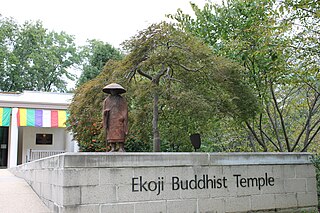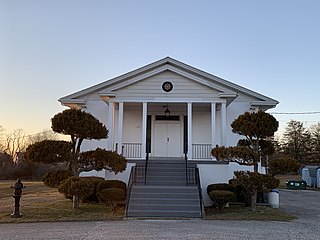
Taiko are a broad range of Japanese percussion instruments. In Japanese, the term taiko refers to any kind of drum, but outside Japan, it is used specifically to refer to any of the various Japanese drums called wadaiko and to the form of ensemble taiko drumming more specifically called kumi-daiko. The process of constructing taiko varies between manufacturers, and the preparation of both the drum body and skin can take several years depending on the method.

Obon or just Bon is a fusion of the ancient Japanese belief in ancestral spirits and a Japanese Buddhist custom to honor the spirits of one's ancestors. This Buddhist–Confucian custom has evolved into a family reunion holiday during which people return to ancestral family places and visit and clean their ancestors' graves when the spirits of ancestors are supposed to revisit the household altars. It has been celebrated in Japan for more than 500 years and traditionally includes a dance, known as Bon Odori.

Ekoji is a temple of the Jōdo Shinshū Hongwanji-ha Japanese Buddhist sect in Fairfax Station, Virginia, near Washington, D.C. It is a member of the Buddhist Churches of America, the oldest Buddhist organization in the mainland United States.
Shoji Kameda is a fourth-generation Japanese American musician and composer, and leading player of North American taiko. He is a founder and member of On Ensemble, a contemporary taiko quartet, and a former member of the jazz fusion group Hiroshima.

Kenny Endo is an American musician and taiko master. He is the leader of several taiko ensembles and regularly tours, performing traditional and contemporary taiko music. Endo is also the first non-Japanese national to receive a natori in the field of hogaku hayashi, Japanese classical drumming. Today Endo composes his own music and plays taiko professionally as a solo artist, with his ensembles, and in collaboration with other artists.
Mark Miyoshi is a Japanese-American taiko maker. He is the owner and principal craftsman at Miyoshi Daiko, based in Mt. Shasta, California.
Johnny Mori is a third-generation (Sansei) Japanese American musician and arts educator/administrator from Los Angeles. He was one of the seminal members of the taiko group Kinnara Taiko and the original taiko drummer for the Grammy nominated jazz-fusion band Hiroshima.

Roy Hirabayashi is a Japanese American composer, performer, teacher and activist known for his work as a leader in North American Taiko. He is co-founder of San Jose Taiko, the group's former Artistic and Executive Director, and was active in developing San Jose's Japantown and arts community.
Ryukyukoku Matsuri Daiko North Carolina is chapter of the Okinawan Eisa taiko ensemble Ryukyukoku Matsuri Daiko. The organization has chapters in Okinawa Prefecture, mainland Japan, Argentina, Brazil, Peru, Bolivia, and various US locations.
Stanford Taiko is a collegiate taiko group based at Stanford University. One of the first collegiate taiko groups to form in North America, it was founded in the winter of 1992 by students Ann Ishimaru and Valerie Mih as a way to share taiko with the university community. As the founding organization of the Intercollegiate Taiko Invitational, Stanford Taiko has been instrumental in the development of collegiate taiko throughout the United States, as well as the larger North American taiko community through performing at the Taiko Jam of the North American Taiko Conference. Since 2000, the group has been active in the international scene through tours and exchange concerts in countries such as Japan, China, and Thailand.
The Midwest Buddhist Temple Taiko group is a self-taught taiko group based in Chicago, Illinois, at the Midwest Buddhist Temple. The group started in 1977 based upon Buddhistic principals after the model of Kinnara Taiko in Los Angeles. The Midwest Buddhist Temple Taiko group performs for the temple, the Buddhist community, the Japanese American community, other communities, commercial gigs, business conferences, and different ethnic fairs. They do not consider themselves to be primarily a performing group, and they do service projects with the temple such as performing at the Midwest Buddhist Temple Ginza Holiday Festival.
Denver Taiko is the fourth taiko group founded in North America and the first taiko ensemble outside of California, United States. The group has a close partnership with the Tri-State Denver Buddhist Temple and performs throughout Colorado and neighboring states. In 2001, Denver Taiko received the Excellence in the Arts Award from Denver Mayor Wellington Webb. Today, Denver Taiko is an ensemble of third, fourth, and fifth generation Japanese Americans with a shared interest in honoring their Japanese American cultural heritage.
Jodaiko is a performing group based in University of California, Irvine that is specialized in taiko. Originally named "Tomo No Taiko", Jodaiko's origins lie in UCI's Japanese-American student group, Tomo No Kai ; it is often referred to as Tomo No Kai's sister group. Tomo No Taiko was founded in 1992 by Peggy Kamon and David Shiwota, both integral members in the Tomo No Kai community, in preparation for 1993 ‘’’Cultural Night’’’. Their influence on the group is reflected through the group's core values of bringing enjoyment of taiko--to both drummers and the audience alike--and spreading Japanese culture. Kamon, in charge of teaching interested Tomo No Kai members how to play taiko, also integrated core Buddhist values into Tomo No Taiko’s practices, performances, and policies. These Buddhist influences are also a result of Jodaiko's connection with Reverend Mas Kodani of Gardena Buddhist Church and Reverend George Matsubayashi of Venice Buddhist Church. Both provided the group with drums or their first performances in 1992, and continue to support their growth as a collegiate taiko group.
UCLA Kyodo Taiko is a collegiate taiko group specializing in taiko drumming. Founded in 1990, Kyodo is the first collegiate taiko group in the country. Kyodo is a Japanese term that means both "family" and "loud children." Many of Kyodo's members are not of Japanese descent.
Seattle Kokon Taiko is a North American taiko ensemble based in Seattle, Washington.
San Francisco Taiko Dojo, founded in 1968 by Grand Master Seiichi Tanaka, was the first taiko group in North America, and has been seen as the primary link between the Japanese and North American branches of the art form. Additionally, Tanaka's belief that learning to play taiko only requires a genuine interest in the art form, has greatly contributed to taiko's success and growth outside Japan.
The Senshin Buddhist Temple is a Buddhist temple in Los Angeles, California. An affiliate of the Buddhist Churches of America (BCA), the temple was built in 1951. It is known for its maintenance of traditional practices and for cultivating one of the earliest taiko groups appearing in the United States under the leadership of Masao Kodani.
Osuwa Daiko (御諏訪太鼓) is a Japanese percussion group credited as the earliest groups to develop and perform the ensemble-style of taiko called kumi-daiko. Formed in Okaya, Japan in 1951 and founded by Daihachi Oguchi, Osuwa Daiko created a style of performance independent from performance during festivals, theatrical performance, and religious ceremonies, and transformed them into an ensemble performance. Contemporary taiko performance in Japan and in the rest of the world is widely based on the practices of Osuwa Daiko.
Seidō Kobayashi is the founder and current leader of the Tokyo-based taiko group, Oedo Sukeroku Taiko. Under Kobayashi's leadership, his taiko group, founded in 1959, was the first to tour professionally. He is considered a master performer of taiko. Kobayashi was well known for attempting to assert intellectual control of the group's performance style, which many believe has influenced taiko performance among many groups, particularly in North America.

The Seabrook Buddhist Temple is a Buddhist temple of the Jōdo Shinshū Hongwanji-ha sect in the Seabrook section of Upper Deerfield Township, New Jersey. It is an affiliate of the Buddhist Churches of America.





